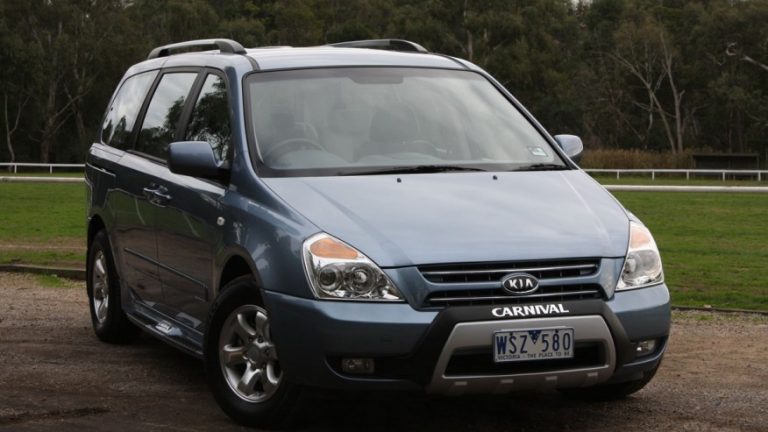 [su_row][su_column size=”1/2″ center=”no” class=””]
[su_row][su_column size=”1/2″ center=”no” class=””]
- Refined 2.4-litre I4 and 2.7-litre V6 engines
- Spacious interior
- Large boot
[/su_column][su_column size=”1/2″ center=”no” class=””]
- Limited steering wheel and seat adjustment
- Firm front seats lack lateral support
- Light, overly-assisted steering lacks precision
- Suspension lacks body control
[/su_column][/su_row][su_image_carousel source=”media: 20591,20592,20593,20594,20595,20596″ limit=”99″ slides_style=”minimal” controls_style=”light” captions=”yes” dots=”no” link=”lightbox” target=”self” autoplay=”3″ title=”always”]
Overview
Released in August 2006, the Kia MG Magentis was a mid-size sedan. Manufactured in Hwasung, South Korea, the front-wheel drive Magentis was powered by either a 2.4-litre four-cylinder or 2.7-litre V6 petrol engine. The Magentis was initially available in two variants: EX and EX-L. From March 2008, however, the Magentis was offered in a single, price-leading LX variant.
Theta II and Mu engines
Of the engines,
- the 2.4-litre G4KC ‘Theta II’ four-cylinder petrol engine had an aluminium cylinder block and head, double overhead camshafts, four valves per cylinder, continuously variable intake valve timing (CVVT) and a compression ratio of 10.5:1; and,
- the 2.7-litre V6 ‘Mu’ engine had an aluminium block and cylinder heads, double overhead camshafts, four valves per cylinder, continuously variable intake valve timing, a variable intake system (VIS) and a compression ratio of 10.4:1;
Dimensions
Compared to the MS Optima which it effectively replaced, the MG Magentis was 15 mm longer (at 4735 mm), 10 mm narrower (1805 mm), 70 mm taller (1480 mm) and had a 20 mm longer wheelbase (2720 mm).
Suspension
Like the Hyundai NF Sonata on which it was based, the Magentis was fitted with MacPherson strut front suspension and multi-link rear suspension (the latter with twin upper and long lower trailing arms). [su_table responsive=”yes”]
| Variant | Years | Engine | Trans. | Peak power | Peak torque |
|---|---|---|---|---|---|
| EX | 2006-08 | 2.4-litre petrol I4 | 5sp man., 5sp auto |
119 kW at 5800 rpm | 221 Nm at 4250 rpm |
| LX | 2008-09 | ||||
| EX-L | 2006-08 | 2.4-litre petrol I4 | 5sp auto | 119 kW at 5800 rpm | 221 Nm at 4250 rpm |
| 2.7-litre petrol V6 | 5sp auto | 138 kW at 6000 rpm | 247 Nm at 4000 rpm |
[/su_table]
Safety equipment
Safety equipment for the EX and EX-L comprised dual front airbags, front side airbags, curtain airbags for front and rear occupants, ABS, brake assist, electronic brake force distribution, electronic stability control, active front headrests and front seatbelts with pretensioners and load limiters. Unfortunately, the LX omitted the front side and curtain airbags.
Euro NCAP crash testing
In Euro NCAP crash testing , a Magentis with a 2.0-litre petrol engine – fitted with dual front airbags, front side airbags and curtain airbags as per the EX and EX-L variants – received a four star adult occupant protection rating with a score of 28.32. In the frontal offset crash test, protection from serious chest injury and leg injury was marginal for the driver and passenger. In the side impact crash test, there was also a moderate risk of serious chest injury for the driver.
Features
Standard features for the Magentis EX included 16-inch alloy wheels, a six speaker sound system with CD player and MP3-compatibility, air conditioning, cruise control, automatic headlights, remote central locking, power windows and mirrors, split and folding rear seats, 12 volt power outlet, tilt adjustable steering wheel, height adjustable driver’s seat, trip computer, alarm and immobiliser.
Beyond this, the Magentis EX-L added 17-inch alloy wheels, climate control air conditioning, leather seats, a power adjustable driver’s seat, front and rear fog lights and a leather-wrapped steering wheel with tilt and reach adjustment.
Compared to the EX, the subsequently released Magentis LX omitted alloy wheels, automatic headlights and the trip computer.
Related links



